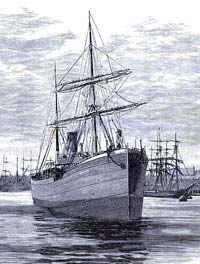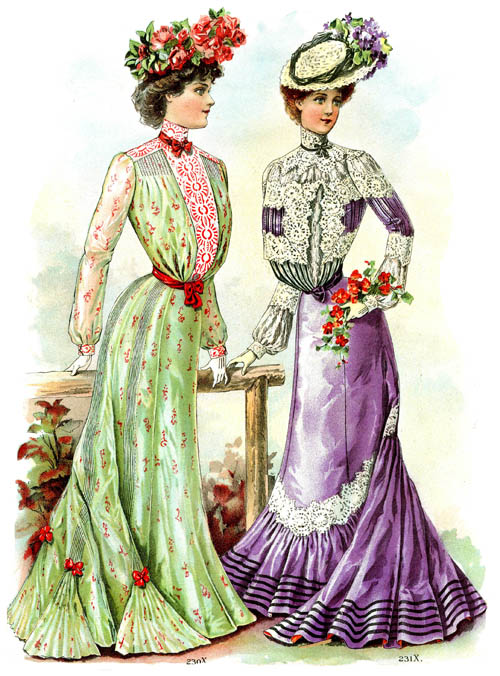|
Home > Victorian Transportation > Steamships

|
The shift from the sailing vessel to the steamship revolutionized ocean (and inland) navigation in the Victorian era. Steamships, constructed of iron rather than wood, could have much larger hulls than sailing vessels. Thus, they could carry far larger amounts of cargo - and far more passengers, leading to the age of the luxury liners. Because steamships created their own power, this made it possible to establish passenger liners with electricity and running water. As steamships could navigate a direct line, relatively unaffected by winds or currents, this led to the establishment of shipping lanes in the Atlantic (basically so that ships wouldn't run into each other!) On the negative side, a steamship had to carry fuel on its voyage (though as you can see from the illustration, early steamships had masts for sails as well).
|
- American River Steamers (Cassell's Family Paper, 1860)
- A look at America's "floating palaces."
- Cars and Stages in America (Leisure Hour 1860)
- A British traveler looks at modes of transporation in the US, including omnibuses, tramway "cars," railways, sleighs or sledges, and riverboats. There is also an interesting observation on "insulting" treatment of blacks on all forms of public conveyance in America.
- The Great Eastern Steam-Ship
(Illustrated London Almanack, 1860)
- (See also Mr. John Scott Russell, builder of the steamship).
- The P&O Company
(Leisure Hour, 1868)
- The "Peninsular and Oriental" line of steamships, primarily sailing the Mediterranean.
- New Steam-Boat and Engines
(Century Magazine, 1882A)
- Ocean Steamships, by S.G.W. Benjamin
(Century Magazine, 1882B)
- Steam-Yachting in America, by S.G.W. Benjamin
(Century Magazine, 1882B)
- Our Iron Walls, by J.W. Steel
(Cassell's Family Magazine, 1883)
- The manufacture of steam ships.
- Our Sailors and Ships
(Cassell's Family Magazine, 1884)
- Some New Inventions, by Charles Barnard
(Century Magazine, 1884A)
- A science roundup that includes developments in steam-ship design.
- The Building of Ships
(Cassell's Family Magazine, 1887)
- The Advance in Steamboat Decoration, by M.G. van Rensselaer
(Century Magazine, 1889B)
- Inland Navigation of the United States, by Charles Barnard
(Century Magazine, 1889B)
- A look at America's luxurious river steamers.
- The First Screw Collier
(Monthly Chronicle of North-County Lore and Legend, 1890)
- The vessel "Q.E.D." marked the transition from wooden sailing ships to iron screw steamers.
- The Ocean Postal Service, by Thomas L. James
(Century Magazine, 1892A)
- The evolution of a system of ocean mail-steamers between the US and Britain.
- The Evolution of a Battleship, by Albert Franklin Matthews
(Century Magazine, 1894B)
- The steam battleship "Indiana." "When the Indiana sails down the Delaware in commission, she will be the ninety-second man-of-war built for the United States navy on the Delaware."
- Monarchs of the Sea: Chats About Some Great Ships Chums, 1895)
- A series on Britain's great steamships.
- [Steamers] Giants of the [Suez] Canal, by C.J. Cutcliffe Hyne
(Cassell's Family Magazine, 1895)
- The Atlantic Greyhound of the Future, by J.H. Biles
(Cassell's Family Magazine, 1896)
- Building an Atlantic Liner, by John Foster Fraser
(Windsor Magazine, 1896B)
- Launching Big Battleships and Ocean Liners, by David Pollock
(The Strand, 1896B)
- A Steamer on Wheels, by James Walter Smith
- A "roller-boat" for crossing the Channel.
(The Strand, 1896B)
- The Amphibious Boat, by James Walter Smith
(The Strand, 1897B)
- A look at a small steam launch in Denmark that ferries passengers over land and water.
- Car Ferries, by John C. Hodson
(The Strand, 1898A)
- A Submarine Boat, by Henry Hale
(The Strand, 1898A)
- Travel Luxury on Land and Sea,
(Windsor, 1898A)
- The Midland Railway; an Atlantic Liner; the South-Eastern Railway.
- The Making of an Armour-Plate [Battleship], by Robert Machray
(Windsor Magazine, 1899B)
- The Building of the "Deutschland," the Swiftest Ocean Steamer, by Ray Stannard Baker
(The Strand, 1900B)
- The Ice-Breaker "Ermack," by Earl Mayo
(Windsor Magazine, 1900B)
- "A Ship that May Yet Navigate to the Pole."
- The Evolution of the Atlantic Greyhound, by Ernest C. Pulbrook
(Windsor Magazine, 1902A)
- "Undoubtedly the greatest advance in shipbuilding within recent years has been the phenomenal increase of the speed of all ships. If anyone had prophesied a few years ago that in [1902], ships capable of steaming 35 knots or more an hour would be launched, he would most probably have been laughed at for his trouble." The author does not view this quest for speed as necessarily a good thing, and blames Americans for seeking the fastest ships so that they can control "both branches of their businesses without loss of time."
- His Majesty's Submarines, by Herbert C. Fyfe
(Good Words, 1902)
- • See also Boats & Sailing Vessels
|
Visit Our Victorian Shop
for:
Books
Coloring Books
Beautiful Spiral Journals
Holiday Greeting Cards
|
|


 Discover thousands of Victorian images in our
Discover thousands of Victorian images in our 